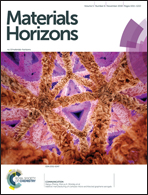A general salt-resistant hydrophilic/hydrophobic nanoporous double layer design for efficient and stable solar water evaporation distillation†
Abstract
A novel and elegant hydrophilic/hydrophobic nanoporous double layer structure was designed and developed for efficient long-term water desalination. It contained a hydrophobic salt-resistant hierarchical layer of well-defined Cu2SnSe3 (or Cu2ZnSnSe4) nanosphere arrays for broad solar harvesting and water vapor evaporation, and a hydrophilic filter membrane for continuous water supply and vapor generation. The as-fabricated self-floatable devices achieve remarkable solar water evaporation performances (average evaporation rate: 1.657 kg m−2 h−1 and solar thermal conversion efficiency: 86.6% under one sun) with super stability for water distillation from seawater and wastewater containing organic dyes, heavy metals and bacteria.

- This article is part of the themed collections: Materials Horizons 10th anniversary regional spotlight collection: China and Materials Horizons Most Popular Articles


 Please wait while we load your content...
Please wait while we load your content...